from Royal Mail:
Seaside Architecture
Issue date: 18th September 2014
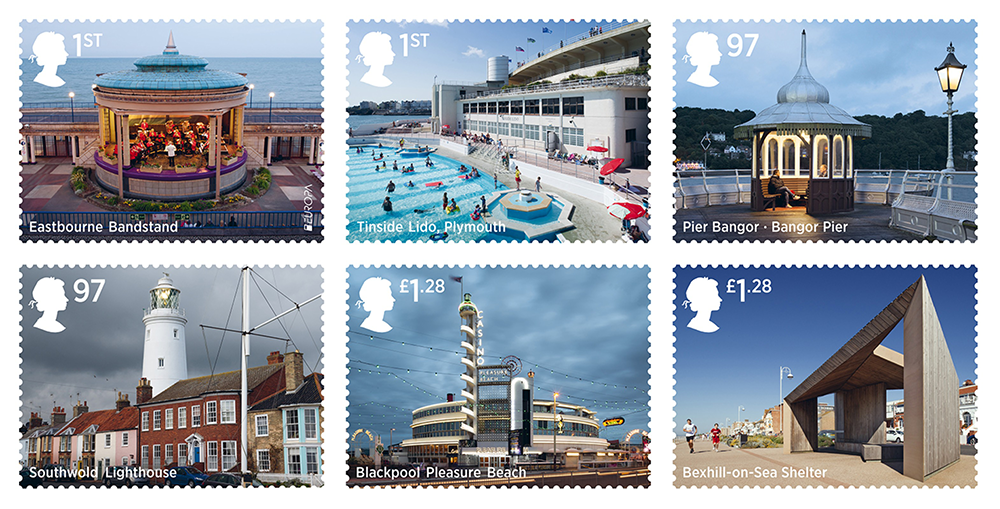 Reason and inspiration:
Reason and inspiration:
The seaside town evolved as a place where the visitor could find a fantasy environment and enjoy entertainments that could not be found elsewhere.
The seaside holiday is a British invention. Scarborough has the honour of being the world’s first seaside resort and is also the location of the first recorded use of the ‘bathing machine’ (1735). It was in the 18th century that visits to the seaside for the health effects of the sea air became fashionable with the wealthy. Getting to the coast though could pose a problem with the choice of expensive stage coaches or slow sailing vessels.
The first piers arose as a solution to reaching these seaside watering places. The first (Ryde Pier, on the Isle of Wight, 1814) was simply a platform to make getting on and off boats easier. With the growth in reliable steam-driven vessels and regular services to places like Margate and Weymouth, piers became the alternative to wading through water or being carried ashore from the boats.
This stamp issue captures the spirit of the seaside experience through the buildings and structures that are exclusive to, or very distinctive of, the UK’s resorts, which were designed for the pleasure of the visitor.
The structures represent the key time periods of seaside development including: Victorian, Art Deco, Modernism of 1930s and up to present day, showing that contemporary architecture/design is being used to regenerate these resorts.
Previous related stamp issues:
- 2011 A-Z: Blackpool; Kursaal
- 2007 Beside the Seaside (ice cream; sandcastle; carousel; beach huts; deckchairs; donkeys)
- 2001 Punch and Judy
- 1998 Lighthouses
Stamps:
 The chosen selection captures distinctive types of seaside architecture from key periods when major investment led to innovation, in particular the late Victorian era and interwar years. There is a good range of resort type – large and small, well-known and less so – from the number one working-class resort of Blackpool to the more sedate Southwold (right) which has grown in popularity as a result of its quiet nostalgic feel. All of the chosen structures are fine examples of their type and the fact that they have been newly photographed as vibrant, well-used places helps celebrate the resurgence of interest in the British seaside which has happened over the last two decades. The contemporary shelter at Bexhill brings the story right up to date.
The chosen selection captures distinctive types of seaside architecture from key periods when major investment led to innovation, in particular the late Victorian era and interwar years. There is a good range of resort type – large and small, well-known and less so – from the number one working-class resort of Blackpool to the more sedate Southwold (right) which has grown in popularity as a result of its quiet nostalgic feel. All of the chosen structures are fine examples of their type and the fact that they have been newly photographed as vibrant, well-used places helps celebrate the resurgence of interest in the British seaside which has happened over the last two decades. The contemporary shelter at Bexhill brings the story right up to date.
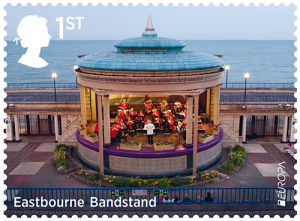 Eastbourne Bandstand – a unique mid-1930s semi-circular design from the Art Deco period but also with a hint of the Orientalism that had been a distinctive feature of seaside architecture since construction the of the Brighton Pavilion. In the days before recorded music and radio, bandstands were to be found at all resorts.
Eastbourne Bandstand – a unique mid-1930s semi-circular design from the Art Deco period but also with a hint of the Orientalism that had been a distinctive feature of seaside architecture since construction the of the Brighton Pavilion. In the days before recorded music and radio, bandstands were to be found at all resorts.
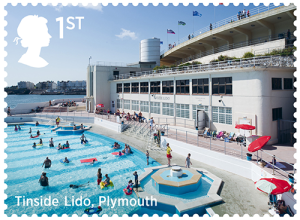 Tinside Lido, Plymouth – One of the best surviving lidos in the country and recently renovated. Built in a Modernist style that really captures the latest fashions of the interwar period, especially outdoor recreation and sunbathing.
Tinside Lido, Plymouth – One of the best surviving lidos in the country and recently renovated. Built in a Modernist style that really captures the latest fashions of the interwar period, especially outdoor recreation and sunbathing.
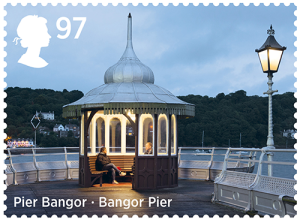 Bangor Pier – Piers represent the great engineering feats achieved in seaside architecture but the Victorians also exploited cast iron in smaller structures that have come to define the seaside atmosphere. The kiosk on Bangor Pier is a great Victorian example on a Welsh pier.
Bangor Pier – Piers represent the great engineering feats achieved in seaside architecture but the Victorians also exploited cast iron in smaller structures that have come to define the seaside atmosphere. The kiosk on Bangor Pier is a great Victorian example on a Welsh pier.
Southwold Lighthouse (illustration above)– Tying in with the Trinity House 500th anniversary in 2014, the lighthouse in the middle of Southwold is one of the symbols of a town that represents a resurgence of seaside popularity based on traditional ‘bucket-and-spade’ activities.
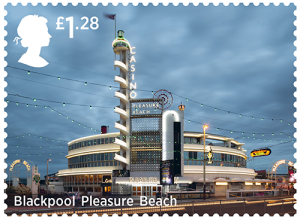 Casino, Blackpool Pleasure Beach – a nationally important example of Modernist architecture and one in which architect Joseph Emberton captured the playfulness of the seaside environment. From its start in the 1890s the Pleasure Beach came into its own during the interwar years and this structure is arguably the culmination of its 1930s revamp.
Casino, Blackpool Pleasure Beach – a nationally important example of Modernist architecture and one in which architect Joseph Emberton captured the playfulness of the seaside environment. From its start in the 1890s the Pleasure Beach came into its own during the interwar years and this structure is arguably the culmination of its 1930s revamp.
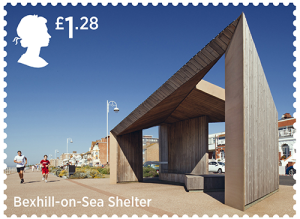 Bexhill-on-Sea Shelter – innovative contemporary architecture has been a major driver of regeneration at the seaside and even seemingly ephemeral structures like shelters can make a big impact on the overall feel of an otherwise traditional promenade. Bexhill-on-Sea has managed to blend a Victorian seafront with iconic 1930s architecture and new 21st-century shelters
Bexhill-on-Sea Shelter – innovative contemporary architecture has been a major driver of regeneration at the seaside and even seemingly ephemeral structures like shelters can make a big impact on the overall feel of an otherwise traditional promenade. Bexhill-on-Sea has managed to blend a Victorian seafront with iconic 1930s architecture and new 21st-century shelters
Stamps: Technical Details:
Stamp Set Price: £5.74
Stamp Set Code: AS34A
Number of stamps: 6: 2 x 1st class, 2 x 97p, 2 x £1.28
Design::Why Not Associates
All photography by Lee Mawdsley
Stamp designs © Royal Mail Group Ltd 2014
Printer: International Security Printers
Print Process: Lithography
Stamp Format / Size: Landscape 41mm x 30mm
Perforations:14.5 x 14
Sheet Format: 6 sheets, 25/50
Phosphor: Bars as appropriate
Minisheet:
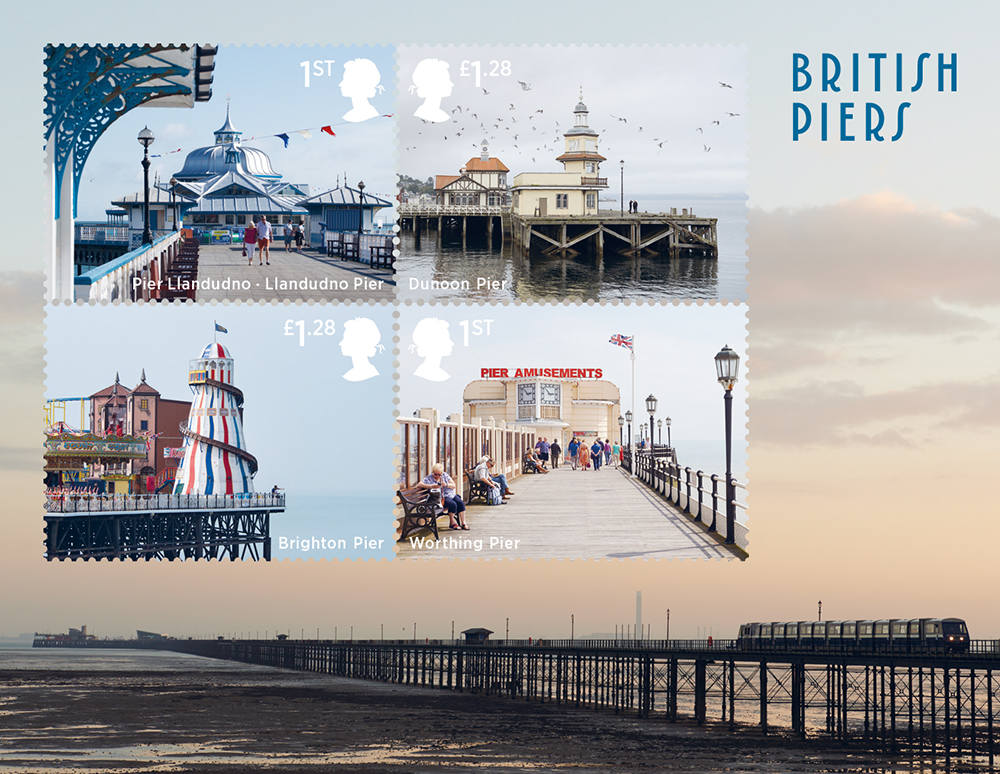 The Barcode version will be supplied as standard for all mint orders from Tallents House and Post Office. A guillotined version, without the barcode, will be used for our products; FDC, Presentation Pack & Annual products
The Barcode version will be supplied as standard for all mint orders from Tallents House and Post Office. A guillotined version, without the barcode, will be used for our products; FDC, Presentation Pack & Annual products
Llandudno – a classic and well-maintained Victorian pier which is the longest in Wales. Great view of the entertainment pavilion with decorative cast iron in the foreground
Dunoon – Scottish example which is still in use by ships like the steamer Waverley. The late Victorian building with its rather domestic-looking timber framed gables is an unusual survival
Brighton – the last surviving of Brighton’s three Victorian piers, still really popular and with a considerable entertainment offer that includes one of the best helter skelters around the coast
Worthing – distinctive 1935 amusements pavilion on a Victorian pier – shows how piers have evolved and links back into interwar structures of main set of stamps
A background image allows for the full impact of Britain’s longest pier at Southend.
Minisheet: Technical Details
Stamp Set Price: £3.80
Stamp Set Code: MZ101
Number of stamps:: 4: 2 x 1st Class, 2 x £1.28
Design:: Why Not Associates
All photography by Lee Mawdsley including the background image of Southend Pier
Printer: Joh. Enschedé Stamps
Print Process: Lithography
Stamp Format / Size: Landscape: 41mm x 30mm
Sheet Size: 115mm x 89mm
Presentation Pack
The design of the Seaside Architecture Presentation Pack was inspired by Art Deco, an artistic movement that had a major influence on the development of British seaside architecture. Designed by Why Not Associates, the pack has a pastel colour palette and features relevant black-and-white and colour photography and illustrations. Writer Kathryn Ferry provides a short history of the evolution of British seaside architecture, beginning with its Georgian origins and concluding with modern-day coastal innovations. A timeline of existing examples of UK seaside architecture complements the editorial content.
First Day Cover
The envelope carries a beach scene featuring Eastbourne Pier and holiday-makers photographed in the early 20th century. Written by Kathryn Ferry, the filler card includes an overview of the development of the British seaside resort, noting its evolution from the 18th century to the modern day. A hand-coloured photograph of Ryde Pier on the Isle of Wight adorns the front side of the card. Designed by Why Not Associates.
Four varieties are available with this stamp issue:
1. Stamps with Tallents House postmark
2. Stamps with alternative postmark
3. Minisheet with Tallents House postmark
4. Minisheet with alternative postmark
Postmarks
The Tallents House postmark features a line drawing of an ornate bandstand located in Brighton. The alternative postmark features references Eastbourne, as the Eastbourne Bandstand stamp is this year’s Europa stamp. The first line of the popular seaside song ‘Oh! I do like to be beside the seaside’ is referenced on the handstamp.
Stamp cards
The six special stamps and four-stamp Miniature Sheet are reproduced at postcard-size in this collectable set of 11 stamp cards (comprising the ten individual stamps and the complete miniature sheet).
Price: £4.95, Code: AQ212



